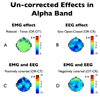Validation of regression-based myogenic correction techniques for scalp and source-localized EEG
- PMID: 19298626
- PMCID: PMC2677703
- DOI: 10.1111/j.1469-8986.2009.00787.x
Validation of regression-based myogenic correction techniques for scalp and source-localized EEG
Abstract
EEG and EEG source-estimation are susceptible to electromyographic artifacts (EMG) generated by the cranial muscles. EMG can mask genuine effects or masquerade as a legitimate effect-even in low frequencies, such as alpha (8-13 Hz). Although regression-based correction has been used previously, only cursory attempts at validation exist, and the utility for source-localized data is unknown. To address this, EEG was recorded from 17 participants while neurogenic and myogenic activity were factorially varied. We assessed the sensitivity and specificity of four regression-based techniques: between-subjects, between-subjects using difference-scores, within-subjects condition-wise, and within-subject epoch-wise on the scalp and in data modeled using the LORETA algorithm. Although within-subject epoch-wise showed superior performance on the scalp, no technique succeeded in the source-space. Aside from validating the novel epoch-wise methods on the scalp, we highlight methods requiring further development.
Figures








References
-
- Allen JJ, Coan JA, Nazarian M. Issues and assumptions on the road from raw signals to metrics of frontal EEG asymmetry in emotion. Biological psychology. 2004;67(1–2):183–218. - PubMed
-
- Barlow JS. EMG artifact minimization during clinical EEG recordings by special analog filtering. Electroencephalography and clinical neurophysiology. 1984;58(2):161–174. - PubMed
-
- Berg P, Scherg M. Dipole models of eye movements and blinks. Electroencephalography and clinical neurophysiology. 1991;79(1):36–44. - PubMed
-
- Berger H. Uber das elektroenkephalogramm des Menschen IV. Archiv fur Psychiatrie und Nervenkrankheiten. 1932;97:6–26.
Publication types
MeSH terms
Grants and funding
LinkOut - more resources
Full Text Sources

